Finally for this time, another slicing cut towards the body - useful for shaping the handle. Note how the spoonbowl is wedged into my chest for support and the thumb is bracing the other end. Hopefully it's clearer to see here how a slicing cut is achieved by lowering the knife hand as the knife is drawn towards the body.
Sunday 25 April 2010
Carving a wooden spoon Pt2
Having done some heavy excavating of the bowl with the Adze, I tidied up a bit using spoon knives. You may notice there are 2 knives on the chopping block; one is bevelled right handed, the other left handed. Having both patterns I find very useful for attaining clean cuts in the bowl 'with the grain' . The important point to bare in mind when using spoon knives is to sweep the cut so that the bevel is in constant contact with the wood behind the cutting edge. This is the best way to get a nice clean cut and no 'chatter'. I'll take some pics to illustrate what I mean some time. There's a troublesome knot just below my little finger which goes right through so will have to be removed; This will affect my design options, but que sera, that's wood for you!
 Next job is to start shaping the bowl with the straight whittling knife. The pic below shows the rough shaping.
Next job is to start shaping the bowl with the straight whittling knife. The pic below shows the rough shaping.
 And an overall view showing some material removed from the handle as well.
And an overall view showing some material removed from the handle as well.
 I got the wife to take some photos of the roughing out knife cuts on a different spoon to illustrate the techniques. The first one is the 'chicken wings'. The first point to note here is that the elbows and upper arms are braced tightly against the chest, isolating the hands and permitting control. Also the cut is started at the hilt end of the blade so that as the cut progresses, a slicing action is introduced making the cut far more efficient.
I got the wife to take some photos of the roughing out knife cuts on a different spoon to illustrate the techniques. The first one is the 'chicken wings'. The first point to note here is that the elbows and upper arms are braced tightly against the chest, isolating the hands and permitting control. Also the cut is started at the hilt end of the blade so that as the cut progresses, a slicing action is introduced making the cut far more efficient.
 Here is the end of the cut, the elbows remaining pulled into the chest. Before you start the cut be aware of other people nearby, especially in the arc the knife tip will take as it leaves the wood. Also just be aware of the position of the hand holding the spoon so that you don,t catch it with the tip of the knife. A lot of power can be imparted into the cut using this technique.
Here is the end of the cut, the elbows remaining pulled into the chest. Before you start the cut be aware of other people nearby, especially in the arc the knife tip will take as it leaves the wood. Also just be aware of the position of the hand holding the spoon so that you don,t catch it with the tip of the knife. A lot of power can be imparted into the cut using this technique.
 Here's another cut, this time with the blade travelling towards you. The strength is in the leverage at the thumb joint. The cutting action is just the clenching of the knife handle into the palm. So at the start of the cut the fingers are open, and as the cut progresses the fingers curl tightly into the palm. This means that the length of travel is limited and the blade doesn't come anywhere near the thumb. If you're working near the edge, of say a bowl, then keep the thumb below the point where the knife leaves the wood. Note again that a slicing action is much more efficient.
Here's another cut, this time with the blade travelling towards you. The strength is in the leverage at the thumb joint. The cutting action is just the clenching of the knife handle into the palm. So at the start of the cut the fingers are open, and as the cut progresses the fingers curl tightly into the palm. This means that the length of travel is limited and the blade doesn't come anywhere near the thumb. If you're working near the edge, of say a bowl, then keep the thumb below the point where the knife leaves the wood. Note again that a slicing action is much more efficient.
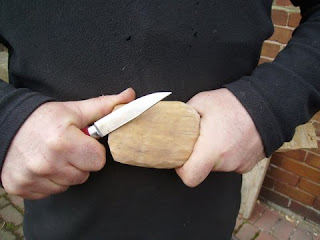
Finally for this time, another slicing cut towards the body - useful for shaping the handle. Note how the spoonbowl is wedged into my chest for support and the thumb is bracing the other end. Hopefully it's clearer to see here how a slicing cut is achieved by lowering the knife hand as the knife is drawn towards the body.
Finally for this time, another slicing cut towards the body - useful for shaping the handle. Note how the spoonbowl is wedged into my chest for support and the thumb is bracing the other end. Hopefully it's clearer to see here how a slicing cut is achieved by lowering the knife hand as the knife is drawn towards the body.
Monday 19 April 2010
Carving a spoon Pt1
This time I've made a conscious effort to photograph the various stages in carving a wooden spoon. Ok it's not rocket science but it may be of interest to those who have thought about, but not had a go at making one.
The first decision is what wood to use. You can use just about any timber you like as long as it is non toxic and I would actively encourage experimentation. In Scandinavia they tend to use softwood and Birch as that's what is most widely available. I have carved with birch quite a bit and it is lovely timber to carve; but you have to know when to stop carving green and allow seasoning before the finishing cuts as it is quite fibrous and woolly in this state. I like carving with any fruitwood such as Apple, Pear, Plum, Blackthorn etc. The timber is nice and easy to carve green and a highly polished, faceted finish can be achieved on the final piece. If your spoon is going to be placed in the mouth, then it should be made from timber that doesn't have a strong taste, ie:- will not taint the food. So wood such as Walnut, Oak, Chestnut etc, which have high tanin content would not be suitable. Instead Beech and Sycamore are traditionally used for treen as they have no taste (the aforementioned fruitwoods are also fine).
I am going to make my spoon from Sycamore as I came across this pile of recent sneddings in my local woods and it just so happens that Sycamore is my favourite timber to carve.
 To make it a little more interesting, I'm going to have a go at making a ladle, so I sought out a sharp crook that will do for my blank. When you look for a crook try and find one with as sharp an angle as possible, as they do straighten out somewhat as the timber dries, which can sometimes be frustrating. I cut the blank down a bit for carrying home, allowing plenty of extra material in case end shakes appear. Sycamore is not very prone to cracking, but some woods crack instantaneously so plenty of allowance must be made.
To make it a little more interesting, I'm going to have a go at making a ladle, so I sought out a sharp crook that will do for my blank. When you look for a crook try and find one with as sharp an angle as possible, as they do straighten out somewhat as the timber dries, which can sometimes be frustrating. I cut the blank down a bit for carrying home, allowing plenty of extra material in case end shakes appear. Sycamore is not very prone to cracking, but some woods crack instantaneously so plenty of allowance must be made.
 Now the tricky bit of splitting the crook. Start at the bowl end and knock the axe in so that it goes through the pith and is tangential to the crook (or spoon handle if you like). Then come in from the top of the crook, again tangential to the bowl and through the pith; hopefully the two splits should meet somewhere in the sharp point of the crook. You may need a couple of axes to complete the split, as I did. Almost invariably the inside piece is the most suitable blank and mine was no exception; you may be able to see a branch growing from the underside of the outer part, rendering it useless.
Now the tricky bit of splitting the crook. Start at the bowl end and knock the axe in so that it goes through the pith and is tangential to the crook (or spoon handle if you like). Then come in from the top of the crook, again tangential to the bowl and through the pith; hopefully the two splits should meet somewhere in the sharp point of the crook. You may need a couple of axes to complete the split, as I did. Almost invariably the inside piece is the most suitable blank and mine was no exception; you may be able to see a branch growing from the underside of the outer part, rendering it useless.
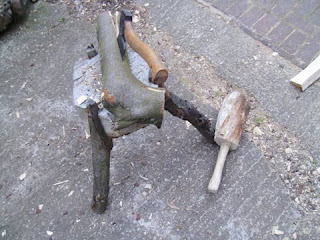
At this point it is very important to be quite ruthless with the axe and remove all bark and 'mine-out' any major defects before you have invested too much time in the project. You can always get another lump of wood so be ruthless. I had to remove quite a lot of material to get a decent blank, but I think there's enough left to make something.
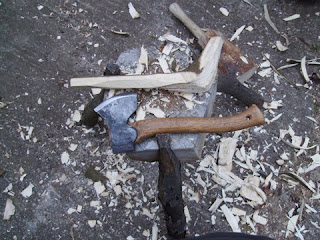
The axe I'm using is a Gransfors Bruks large carving axe which I get on really well with-it was quite an investment but without doubt worth every penny. You should remove as much material as possible with the axe, working towards a rough shape. This will make knife work easier and quicker. Remember to always work lower on the blank than your fingers and keep inverting the blank end-on-end.
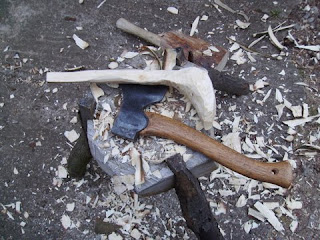
There's the blank roughed out. Next job is to start rough forming the bowl with the Bowl-Adze, again to make sure we don't have any defects which may cause a design re-think. That's an important point actually, as I never start a spoon with a fixed design in mind, I often have to alter direction to work round a defect, and as long as there's still enough material, let the piece evolve.
The first decision is what wood to use. You can use just about any timber you like as long as it is non toxic and I would actively encourage experimentation. In Scandinavia they tend to use softwood and Birch as that's what is most widely available. I have carved with birch quite a bit and it is lovely timber to carve; but you have to know when to stop carving green and allow seasoning before the finishing cuts as it is quite fibrous and woolly in this state. I like carving with any fruitwood such as Apple, Pear, Plum, Blackthorn etc. The timber is nice and easy to carve green and a highly polished, faceted finish can be achieved on the final piece. If your spoon is going to be placed in the mouth, then it should be made from timber that doesn't have a strong taste, ie:- will not taint the food. So wood such as Walnut, Oak, Chestnut etc, which have high tanin content would not be suitable. Instead Beech and Sycamore are traditionally used for treen as they have no taste (the aforementioned fruitwoods are also fine).
I am going to make my spoon from Sycamore as I came across this pile of recent sneddings in my local woods and it just so happens that Sycamore is my favourite timber to carve.
At this point it is very important to be quite ruthless with the axe and remove all bark and 'mine-out' any major defects before you have invested too much time in the project. You can always get another lump of wood so be ruthless. I had to remove quite a lot of material to get a decent blank, but I think there's enough left to make something.
The axe I'm using is a Gransfors Bruks large carving axe which I get on really well with-it was quite an investment but without doubt worth every penny. You should remove as much material as possible with the axe, working towards a rough shape. This will make knife work easier and quicker. Remember to always work lower on the blank than your fingers and keep inverting the blank end-on-end.
There's the blank roughed out. Next job is to start rough forming the bowl with the Bowl-Adze, again to make sure we don't have any defects which may cause a design re-think. That's an important point actually, as I never start a spoon with a fixed design in mind, I often have to alter direction to work round a defect, and as long as there's still enough material, let the piece evolve.
The Bowl adze is by Hans Karlsson and is a beauty. I think it's worth sourcing the best hand tools for the task and when you think about it , barring a major catastrophe, they should last a lifetime.

That's as far as it goes for now. The blank is still fairly wet and will be put in a plastic carrier bag with some shavings and kept somewhere cool and dark until next time.
That's as far as it goes for now. The blank is still fairly wet and will be put in a plastic carrier bag with some shavings and kept somewhere cool and dark until next time.
Cheers for now
Saturday 10 April 2010
Axe handle
How frustrating is it posting on Blogger! This post was originally going to be put up a couple of days ago, but after an hour or so's composition I lost the lot when I tested a web link and then pressed "back" only to find a blank page! I did write a paragraph about what it's like entering a burning building and not knowing what to expect on the other side of the door, but I won't go through it again- maybe some other time. This was prompted by the tragic deaths of 2 Hampshire Firefighters who perished in Southampton the same night I was on duty myself. My condolences go out to the friends, family and colleagues of these 2 men.
I haven't had much free time for being creative as I'm in the middle of making some built-in units for the bedroom out of Oak veneered MDF and the wife has been on my case to make some progress. Didn't take any photos of me ripping down 8ft x 4ft sheets of MDF and making cupboards as they don't exactly make eye candy: maybe I'll take a few pics when the project is finished. I did however make time to start re handling some axe heads that have been awaiting some attention.
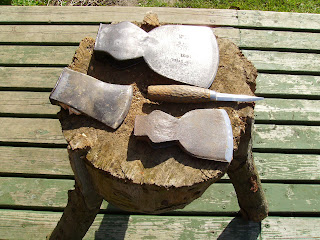 The largest one at the top is a 31/2Lb kent pattern head that I intend grinding to make a non offset Hewing axe that can be used to square both sides of a log without having to turn round. The handle will be almost straight and about 18 to 20" long, as per the Gransfors version. I won't be detailing the process of re handling an axe as there's an excellent tutorial here
The largest one at the top is a 31/2Lb kent pattern head that I intend grinding to make a non offset Hewing axe that can be used to square both sides of a log without having to turn round. The handle will be almost straight and about 18 to 20" long, as per the Gransfors version. I won't be detailing the process of re handling an axe as there's an excellent tutorial here
As per the advice given in the article I am using Ash (Fraxinus Excelsior) for my handles, this piece was felled about 12 months ago so shouldn't take too long to dry.
 I roughed out the basic shape leaving it oversize by about 20% to leave plenty of scope for refining once the blank has dried. For scale the axe to the left of the blank is my trusty Gransfors Bruks Large Carving Axe.
I roughed out the basic shape leaving it oversize by about 20% to leave plenty of scope for refining once the blank has dried. For scale the axe to the left of the blank is my trusty Gransfors Bruks Large Carving Axe.
 The blank will now be left in a warm part of the house for 2 weeks and allowed to dry before the head is fitted. Here's an update on my progress with the Sycamore kuksa I've been carving. This too is now at the stage where it needs to be left to fully dry out before it is finished. The only way to achieve the clean facetted finish is to fully dry the piece as fibres tend to pull out and leave a woolly finish if finishing cuts are attempted on wet wood.
The blank will now be left in a warm part of the house for 2 weeks and allowed to dry before the head is fitted. Here's an update on my progress with the Sycamore kuksa I've been carving. This too is now at the stage where it needs to be left to fully dry out before it is finished. The only way to achieve the clean facetted finish is to fully dry the piece as fibres tend to pull out and leave a woolly finish if finishing cuts are attempted on wet wood.
I haven't had much free time for being creative as I'm in the middle of making some built-in units for the bedroom out of Oak veneered MDF and the wife has been on my case to make some progress. Didn't take any photos of me ripping down 8ft x 4ft sheets of MDF and making cupboards as they don't exactly make eye candy: maybe I'll take a few pics when the project is finished. I did however make time to start re handling some axe heads that have been awaiting some attention.
As per the advice given in the article I am using Ash (Fraxinus Excelsior) for my handles, this piece was felled about 12 months ago so shouldn't take too long to dry.
Tuesday 6 April 2010
Carving a Kuksa
Well it's been a while since I posted anything myself but I love reading other people's blogs relating to the subjects that interest me. The quality of some of them is astounding, which is a bit intimidating; but mine was only ever meant as a record of things I've made for my own reference anyway so hopefully I'll start posting regularly from now on. I am very ad hoc in the way I use my spare time, which means I may start off doing one thing, pick up a lump of wood and carve a ladle or something just for the hell of it. In future I'll try and think on and get the camera to take a few WIP photos.
This is the start of a carved Kuksa:- a scandinavian drinking vessel. I am using a lump of Sycamore (Acer Pseudoplatanus) for this little project, which incorporates some nice burr or burl. I took a slab about 4 inches thick and roughed it out on the bandsaw, this is the only power tool used in this particular project
 Here you can see the underside and some of the nice burr figure. The bowl af the cup has been roughly shaped with the axe.
Here you can see the underside and some of the nice burr figure. The bowl af the cup has been roughly shaped with the axe.
 From the top I have started excavating with a spoon knife, and already the burr figure is appearing in the bottom. Deep hollowing with spoon knives is extremely wearing on the hands and wrists so I think I will get some spoon knives, blade only, and fix long handles on them to increase the leverage for this task. Incidentally, I find in very beneficial to have both right and left handed spoon knives for "cutting with the grain" in a cylinder.
From the top I have started excavating with a spoon knife, and already the burr figure is appearing in the bottom. Deep hollowing with spoon knives is extremely wearing on the hands and wrists so I think I will get some spoon knives, blade only, and fix long handles on them to increase the leverage for this task. Incidentally, I find in very beneficial to have both right and left handed spoon knives for "cutting with the grain" in a cylinder.
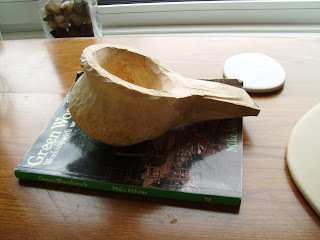 I never set out with a specific design brief when I make things, I just let the design evolve as I go. Here I thought I'd allow an undercut, similar to mugs turned by potters- I'll see how it works out.
I never set out with a specific design brief when I make things, I just let the design evolve as I go. Here I thought I'd allow an undercut, similar to mugs turned by potters- I'll see how it works out.
This is the start of a carved Kuksa:- a scandinavian drinking vessel. I am using a lump of Sycamore (Acer Pseudoplatanus) for this little project, which incorporates some nice burr or burl. I took a slab about 4 inches thick and roughed it out on the bandsaw, this is the only power tool used in this particular project
This is as far as I got on the first day. It's helpful to remove as much material as possible whilst the timber is still wet, as the material is much softer in this state. If you have to leave itand come back to it: wrap the piece in a plastic bag with some shavings to prolong this period. I wouldn't leave it in a carrier for too long though, as mildew can form and stain the wood after a while, a particular problem with timber such as Sycamore which stains easily.
I intend writing individual posts about my thoughts on specific native timbers, but for now just an observation on this Sycamore tree. The grain in the timber is 'Rippled' which occurs in about 10% of Sycamore trees, I understand. I don't know why this occurs; I used to think it was 'creases' due to a bend in the bough, but every branch in this tree is rippled, so maybe it's something genetic- I've never heard an explanation. Here you can see the fine ripples (or 'fiddleback') in the grain.
Subscribe to:
Posts (Atom)
